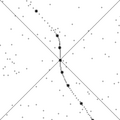Time facts for kids
Time is the never-ending continued progress of existence and events. It happens in an apparently irreversible way from the past, through the present to the future.
To measure time, we can use anything that repeats itself regularly. One example is the start of a new day (as Earth rotates on its axis). Two more are the phases of the moon (as it orbits the Earth), and the seasons of the year (as the Earth orbits the Sun).
Even in ancient times, people developed calendars to keep track of the number of days in a year. They also developed sundials that used the moving shadows cast by the sun through the day to measure times smaller than a day. Today, highly accurate clocks can measure time in less than a billionth of a second. The study of time measurement is known as horology.
The SI (International Systems of Units) unit of time is one second, written as s. When used as a variable in mathematics, time is often represented by the symbol  .
.
In Einsteinian physics, time and space can be combined into a single concept. For more on the topic, see space-time continuum.
Contents
Units of time
- 1 millennium = 10 centuries = 100 decades = 200 lustrums = 250 quadrenniums = 333.33 trienniums = 500 bienniums = 1,000 years
- 1 century = 10 decades = 20 lustrums = 25 quadrenniums = 33.33 trienniums = 50 bienniums = 100 years
- 1 decade = 2 lustrums = 2.5 quadrenniums = 3.33 trienniums = 5 bienniums = 10 years
- 1 year = 12 months = 52 weeks = 365 days (366 days in leap years)
- 1 month = 4 weeks = 2 fortnights = 28 to 31 days
- 1 fortnight = 2 weeks = 14 days
- 1 week = 7 days
- 1 day = 24 hours
- 1 hour = 60 minutes
- 1 minute = 60 seconds
- 1 second = SI base unit of time
- 1 millisecond = 1/1,000 second
- 1 microsecond = 1/1,000,000 second
- 1 nanosecond = 1/1,000,000,000 second
- 1 picosecond = 1/1,000,000,000,000 of a second
- 1 femtosecond = 1/1,000,000,000,000,000 of a second
- 1 attosecond = 1/1,000,000,000,000,000,000 of a second
- 1 Planck time = smallest measurable unit of time
Things used to measure time
Time of day
Related pages
Images for kids
-
Horizontal sundial in Taganrog
-
A contemporary quartz watch, 2007
-
Chip-scale atomic clocks, such as this one unveiled in 2004, are expected to greatly improve GPS location.
-
Scale of time in Jain texts shown logarithmically
-
Views of spacetime along the world line of a rapidly accelerating observer in a relativistic universe. The events ("dots") that pass the two diagonal lines in the bottom half of the image (the past light cone of the observer in the origin) are the events visible to the observer.
-
Philosopher and psychologist William James
See also
 In Spanish: Tiempo para niños
In Spanish: Tiempo para niños









